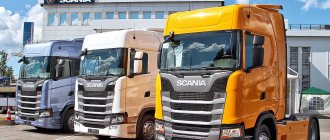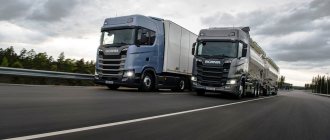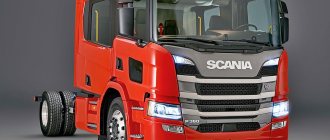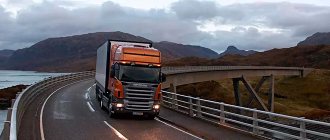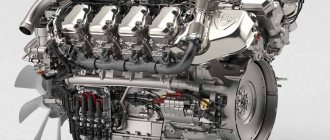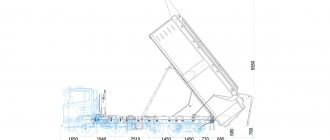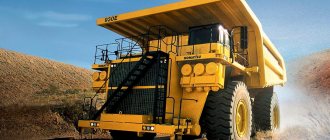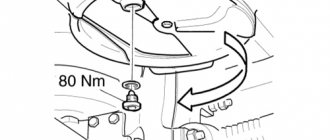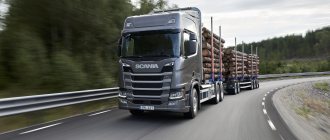Improved Griffin
Alexander Trokhachev, photo by the author
In January 2008, deliveries of the next generation Scania Griffin began to Russia. Like the first public sector car with the same name, it is assembled in Brazil. Without waiting to get acquainted with the car in Moscow, I went for a test drive to the plant, located in the largest business center of South America - the city of Sao Paulo.
Origins of the project
The word “Griffin” appeared in the everyday life of Russian road carriers in 2001, when the Scania company project of the same name was launched. The Moscow representative office of the company developed it to increase sales and popularize the brand in the transport market. The most popular options were included in the vehicle package. Those that make it easier to operate in a country with a cold climate (let’s not forget that we have “bad weather for six months, nothing at all for six months”) and do not make it very expensive. But the savings were not always justified: carriers were not satisfied with the modest cabin without an acceptable level of comfort for truck drivers, and the weak engine allowed the car to be used only in the flat part of the country, that is, mainly to the Urals.
The first generation Griffin was equipped with a 9-liter Euro 2 engine with 310 hp. This was frankly not enough. However, the reliability of mechanical fuel injection pumps was beyond doubt, the build quality was excellent, and carriers fell in love with the car for its simplicity and maintainability. But there were objective complaints about the P cab of the 4th Scania series: truckers needed two berths, not one, and there was nowhere to put a “wet” stove. The capacity of standard batteries was not enough, and transport workers wanted to increase the fuel tank to the maximum possible volume. In short, the product was not ideal in all respects, but it had one important advantage - a price acceptable for Russian carriers. Actually, she played a major role in the “national love” for this car. According to one of the foreign businessmen, “with the Griffin project, Scania simply dealt a blow to its competitors in the gut, and some have not yet recovered from this blow.”
Time passed, and budget versions of European foreign cars appeared in all market players without exception, representing the “Big Seven”: DAF, IVECO, MAN, Mercedes Benz, Renault, Scania, Volvo... And yet Scania was the first, and it’s always difficult to be first. Everyone else learned from the example and mistakes of the Swedish manufacturer. Some succeeded to a greater extent, others to a lesser extent. But in the end, as the “foreman of perestroika” Mikhail Gorbachev said, “the process has begun.”
Scania also did not sit idly by and did not intend to rest on its laurels as the No. 1 brand on the Russian truck market. In the fall of 2004, the Griffin project received a second wind. The cars began to be equipped with 11-liter Euro 3 engines with a power of 340 hp. And in the fall of 2005, the Russian representative office of the Swedish company in a solemn ceremony celebrated the sale of the two thousandth car in a special version. In 2006, the dream of thousands of domestic carriers finally came true: Griffin received a double Space cabin of increased volume. Disappointed competitors could only throw up their hands in surprise...
But no matter what they say, Griffin played a special role in the development of the Russian cargo transportation market by road. The success of the project is confirmed by positive feedback from the field and the assessment of professionals, who twice - in 2002 and 2007 - recognized Griffin as the “Best Foreign Truck of the Year in Russia.” Thanks exclusively to him, Scania has been the leader in the domestic market in terms of sales of new trucks for seven years in a row and has become one of the company’s top five priority markets worldwide. And Griffin itself became the most popular European-made truck in Russia.
Perestroika without disasters
The promotion of the Swedish brand on the South American market began already in 1948: Brazil, like Argentina, remained neutral in World War II, and the fulfillment of military and food orders for the United States and Europe provided a powerful incentive for the development of the extractive industries and the agricultural sector. Latin America experienced a transport boom, but real expansion was still a long way off. In 1951, Scania acquired a local official importer, Vemag Group. In 1953, the plant was founded, and on July 2, 1957, the company Scania-Vabis do Brasil SA – Motores Diesel was registered. Brazilian history began from this date.
The first Scania L75 bonnet was assembled in Brazil in 1958. And it already contained a share of domestic components. According to local legislation, the degree of localization of production had to be at least 35%. The legal requirements were fully complied with (rubber rubber, plastic, glass, springs, fittings, electrical appliances). And although this year is officially considered the birthday of the company’s first products, the plant in Sao Paulo (Ipiranga) launched mass large-scale assembly production only 50 years ago. The most popular by that time was the D10 power unit with a capacity of 165 hp. s., which had few analogues in this price class, it was also superior to the American gasoline “eights” of Ford and GM, especially in the rural areas and in the “hungry regions” of Peru and Chile.
Trucks of the L75 series with a gross weight from 12.6 to 20 tons played their role not only on the American continent. In the early 1960s, the European branches of Scania-Vabis in Holland and Denmark began their own history with the serial production of the L75 model. So the event turned out to be significant in many ways.
In 1960, the Brazilians decided to group all production, uniting it in a compact area in Sao Bernardo do Campo. All the specialists involved in the production of trucks, bus chassis and engines were boiled in this cauldron at once. Although the plant did not develop at an intensive pace, like KamAZ or AvtoVAZ, performing such feats here for the sake of subsequent growth is harmful to the economy: the enterprise and the market should evolve, and not experience the catastrophes of perestroika.
By the way…
Griffin is the English name for the ancient mythological creature griffin: powerful, fast and resilient. According to marketers, the company’s product is endowed with precisely these qualities. It is not for nothing that the image of a griffin has been adorning the corporate emblem for more than 100 years. By the way, the screen profile of the fairy bird is on absolutely all trucks sent to Russia. According to the authors of the project, cars can only be white, blue or red - like on the national flag of our country. It is curious that carriers have different interpretations of the graphic image on the sides of the cabin. Ill-wishers make sarcastic comments: they say that the griffin has stuck out its tongue and is angry that it is difficult for him to do his job. And fans of the brand have their own arguments: he is simply very strict and sticks his tongue out at his competitors - well, have you eaten?!
Innovations
In 2008, Griffin's competitiveness is taken to a new level. The list of improvements is so voluminous that simply listing it would be a thankless task. By the way, to avoid confusion, the new generation is called not just Griffin, but New Griffin. I learned the main changes on the factory test track together with instructors, who took turns talking about improving the design and expanding the list of equipment installed on cars for the Russian market.
So, let's talk about Brazilian trucks for the Russian market. And let's start, perhaps, with dual-axle vehicles. These are perhaps the most common and most in demand tractors by carriers. Typically, such vehicles are used in Russia at medium-haul distances. However, there are many examples of budget “Swedes” being used on international flights. From now on, the two-axle New Griffins are equipped with new P and G series cabs, which we will return to later. In the meantime, let’s talk about the advantages over the previous model.
The improved 4x2 tractor received a reinforced rear axle. Now it is designed for a maximum permissible load of 13 tons. However, this does not mean that you can load the car as you please. The Russian representative office clearly instructed official dealers as to in what cases the client may lose the factory warranty. This also applies to the independent decision to install an additional fuel tank on the left side of the frame instead of a spare wheel. The manufacturer considers a diesel fuel supply of 600 liters sufficient. By the way, on the predecessor the tank capacity was only 450 liters. The material chosen for the tank is the same - aluminum. The benefit is obvious: weight is reduced and corrosion resistance is increased.
The front bumper now has a built-in underrun guard. In the event of a collision with a passenger car, it will protect the other vehicle from diving and thereby save the life of the driver and passengers. The bumper finally has additional fog lights, which cannot be called superfluous even if you wanted to. Whatever you say, our roads are such that it’s better to play it safe - with a second pair of auxiliary optics, the car is more noticeable on the road, and the driver is calmer. The familiar wheels are shod with low-profile tires measuring 315/70 R22.5. There are several reasons for its installation. Firstly, it allows the use of a low saddle to work with modern European trucks. Secondly, such tires provide the vehicle with a very smooth ride, which is important for any type of cargo transportation. Finally, the low profile rubber guarantees excellent directional stability of the truck and the hitch as a whole. In general, there are plenty of arguments in its favor.
It's finished! Heeding the pleas of carriers, the plant began equipping vehicles with batteries with increased capacity - 225 Ah. The previous Griffin had a battery capacity of only 175 Ah, which was not enough, especially for the northern regions and Siberia. Why, Siberia - even in the central zone of Russia, they don’t know about the problems of cold starts in winter from books. Yes! In addition to the 340 hp 11-liter Euro 3 engine, the improved Griffin received a 12-liter power unit producing 380 hp. The engine is also from the line of four-stroke 6-cylinder in-line diesel engines with direct injection and intermediate air cooling. Torquey and torquey, with good torque.
By the way…
From Scania's safety seminar, we know that braking a heavy-duty truck (like the Griffin) from 90 km/h to a stop generates a huge amount of heat, enough to boil 54 liters of water in 4 seconds! The standard brake system, and in particular the brake pads, must withstand this crazy heat. Moreover, after such a shock, they must retain the ability to further brake and cool down as quickly as possible. But only original spare parts can do this, and fakes may not restore the original characteristics. Therefore, experts advise dealing only with branded products recommended by the manufacturer.
Kara chat
In the history of the entire Brazilian automotive industry and Scania do Brasil, 1969 became a significant year. 40 years ago, Scania became the first national manufacturer of auto parts for export. Oil pumps from Brazil began to be installed on engines manufactured in Sweden.
In 1974, a Brazilian company introduced cabover cabovers into production. The carrier of this innovative idea was the LK140 model, which in Brazil received the nickname cara chata - “flat face”. By the way, in local slang the word “skanya” means nothing more than “big truck”. By the time the millionth vehicle was produced in 2000, parts from 11 Scania factories in Europe and Latin America were used in its manufacture.
The Brazilian site is the first full-cycle facility among Scania plants outside the Kingdom of Sweden. Even the plant in Zwolle (Netherlands) was put into operation two years later - in 1964. But the plant based in São Bernardo do Campo is not the only Scania site in Latin America. In addition, the company owns an assembly plant in Mexico and a plant for the production of transmissions and drive axles in Tucuman, Argentina. Over the years, production was launched in Denmark, Morocco, Tanzania, Iraq, the USA, Peru, Australia and China.
Biaxial Joy
The improved Griffin as a 4x2 tractor received a reinforced frame with side members with a total thickness of 9.5 mm. For the harsh Russian conditions, this is “what the doctor ordered.” The maximum load on the front axle was 7.5 tons, and on the rear axle – 13 tons. Based on the experience of competitors, it is known that the practice of using a reinforced front axle with a permissible load of 9 tons did not justify itself. At least for long-haul transportation, this is clearly an overkill, fraught with increased costs. So the prescribed 7.5 tons per eye is enough.
During the test, the joy of getting to know the 4x2 car was overshadowed by the unclear inclusion of the lowering row. The gearbox was capricious even in the hands of the instructor, who did not hide his irritation with this fact. And other drivers who got behind the wheel took notice of this. It is strange that a new car, which came off the factory assembly line and did not have time to be in the hands of “dinosaurs”, is already, in fact, defective. The question involuntarily arises: was the rejection of components and assemblies carried out at the plant or were they installed indiscriminately? I’m writing this not for the sake of a nice word, but because I imagined myself in the role of a buyer who suddenly encountered such a problem...
However, I am not inclined to cast a shadow over the fence; after all, this is not a transfer of equipment to the customer, but only a test drive. By the way, after some time, test drives on this particular tractor stopped, and I was left with another two-axle vehicle. Unlike its white “colleague,” the red car was completely subordinate to my will and did not “fool.” The problems associated with the first car immediately faded into the background and did not spoil the overall positive perception of the car.
The new Griffin also incorporates much of the best of what has been proven in practice and years of operation. For example, the brakes remained drum brakes. It was not necessary to truly evaluate their effectiveness, since on the factory track I drove “naked” tractors, without semi-trailers and cargo. In addition, the asphalt was practically dry and there were no mud baths along the route. But to be honest, there is no need to question the competence of Swedish and Brazilian specialists: since Russian carriers trust them, why shouldn’t I trust them?!
From the previous wealth, New Griffin inherited a 9-speed (8+1) Scania GR900 gearbox with a divider. The gearbox itself is simple, but I personally prefer the 14-speed (12+2) GRS900 model with a divider, range multiplier and two “creeping” gears. By the way, New Griffin Space comes with it. The box lever is simple and durable, located in a convenient area and there are no complaints about it. Using the divider is also not difficult, the main thing is to do it when the car is completely stopped and do not rush to move the flag down.
Maneuvering on a two-axle vehicle is a pleasure: with a short wheelbase of 3550 mm, it easily fits into sharp turns. And it would be strange if such a car did not also have good maneuverability... But, I repeat, without a truck behind you, it’s somehow incorrect to evaluate the flexibility of a vehicle, honestly...
Viva da Lula!
The plant employees do not drive their guests, but transport them on a Jacto VPX04H* mini-road train. The train with trolleys runs only along wide paths, without turning into narrow passages between production areas.
The guide’s words dissolve in the speakers of the headphones, and I don’t really know what to give preference to: listening to the story, contemplating the production workshops, or taking photographs of the areas rapidly passing by.
*Sasha painted an instructive story with the study of all Brazilian transport exotics a year ago (see “Gas, Gonzales and Scania” and “Transport of the Country of Pele”), where you can also look at the wonderful cars plying through the territory of the Brazilian division of Scania /Yu.P. / .
From the guide’s flowing speech, I remember that at the beginning of his career, the current President of Brazil, Inácio Luiz Lula da Silva, worked at this plant! Since it is difficult for foreigners to pronounce the full name, Brazilians suggest remembering its abbreviated version - Lula. Judging by the way production workers focus on this, they are proud of this fact.
It was interesting to compare Brazilian production with the reference one in Södertälje. The workshops of the Brazilian enterprise have the same cleanliness, the same polite employees, a similar arrangement of office life - coffee machines and water dispensers along the walls, compact boxes for storing and heating lunches and breakfasts brought with you, small recreation areas. Even an electronic clock indicating the task for the day and current compliance (ahead or behind) of the plan one to one, as in Sweden.
The workers wear snow-white shirts. The dress code is an integral and educational part of the Brazilian production culture and disciplines the assemblers. But in Sweden this is not necessary - in Södertälje, psychologists consider the cult of the dress code for Swedes to be a factor limiting quality.
Another similarity between subsidiary and parent production is the use of modern equipment. The Brazilians are proud to be included in the Scania Production System (SPS), which involves complete unification of technological, production processes and components. In practice, this leads to lower production costs, simplified logistics, reduced additional costs, and the resulting trucks are no different from those produced in Sweden or Holland.
Space - and that says it all
The New Griffin Space version differs from the simple New Griffin in that its cabin is double. Folding ledges have appeared in the lower shelf, allowing the driver and passenger seats to be moved further from the dashboard. Thanks to this simple but very effective solution, you can, without leaving the wheel, relax during hours of forced downtime at the border or in a traffic jam - stretch your legs, straighten your arms and massage stiff joints. But this is not the main thing.
As on the two-axle version, there is a filter-moisture separator, electric heating of the coolant, and also a large box on the left side of the cab with an external hatch. Through the “embrasure” that appears after opening the box, you can take or put drinks, food and some items of clothing or travel equipment directly from the street. There is no need to climb into the cabin.
The three-axle 6x4 version of the Griffin line first appeared in 2003 and has since proven its effectiveness. It would be funny to talk smartly about the advantages and disadvantages of a car without testing it with maximum or at least partial load. And therefore, my impressions of being behind the wheel of a car, excuse me, are “blitz test”. However, from them you can get a fairly complete picture of the car.
I note that the 6x4 tractor has double side members with a total thickness of 17.5 mm. Its center distance is 3700 mm, which has a positive effect on its directional stability, not only on straight sections of roads, but also on high-speed curves. As in the new two-axle vehicle, the instrument panel with a Russified on-board computer is frankly pleasing. Now “Uncle Vasya”, who switched to a foreign car from a domestic truck, will not have to once again call the fleet or ask the service specialist “what kind of inscription is this?” Drivers of the first Griffins struggled with a non-adjustable steering column. For fear of breaking the steering column switches and getting the steering wheel dirty, they had to go to the night through the right door. This is now a thing of the past: on the new version, the steering column is equipped with a pneumatic adjustment lock. It’s easier to tilt the steering wheel forward than to walk around the front of the car and “jump” over the passenger seat.
New Griffin family, developed for the Russian market:
- tractor unit Scania P340 LA 4×2 HNA;
- low loader tractor Scania P340 LA 4×2 HLA;
- tractor unit Scania P340 CA 6×4 HNZ;
- truck tractor Scania P380 CA 6×4 HNZ;
- Scania G340 LA 4×2 HNA truck tractor with Space double cab;
- Scania G380 LA 4×2 HNA truck tractor with Space double cab;
- low loader tractor Scania G380 LA 4×2 HLA with double cabin
At the request of the carriers, an additional side canopy was installed in the cabin to protect from the sun. The thing is not only convenient, but also extremely useful, especially in spring and summer. The driver's seat is a special place: its adjustments will help you adjust the cushion and backrest to any height, build and body weight. The driver's partner was also taken care of. Thanks to the folding mechanism of the seat, it can increase the space available for relaxation. Finally, the CG19 cab is additionally equipped with electrically adjustable rear-view mirrors and electric windows. The step is completely justified - sometimes the driver is alone in the cab, but you need to clarify the address, ask about the route, or just exchange a few phrases with a colleague.
Summing up my Brazilian acquaintance with the latest generation of Scania Griffin, I can state: this car has become even better. And market success is guaranteed to him!
The author thanks Scania-Russia LLC Olga Krivonogova, PR service employee, for organizing the trip to Brazil
Blue rating
Finally, how do Brazilians approach their work? They are regularly inspected by Blue Rating inspectors. According to the head of the industrial development and production department, Stefan Palgren, the year-long experiment as part of a program to assess environmental performance, working conditions and safety measures has been completed successfully. The management of the enterprise received high praise for organizing health measures and implementing fitness programs. The plant needs healthy employees, not wrecks suffering from hangovers and burdened with chronic diseases. The Blue Rating program identifies weaknesses and strengths in environmental and worker health practices. And since the Brazilian experience was positive, it will be extended to other Scania enterprises.


